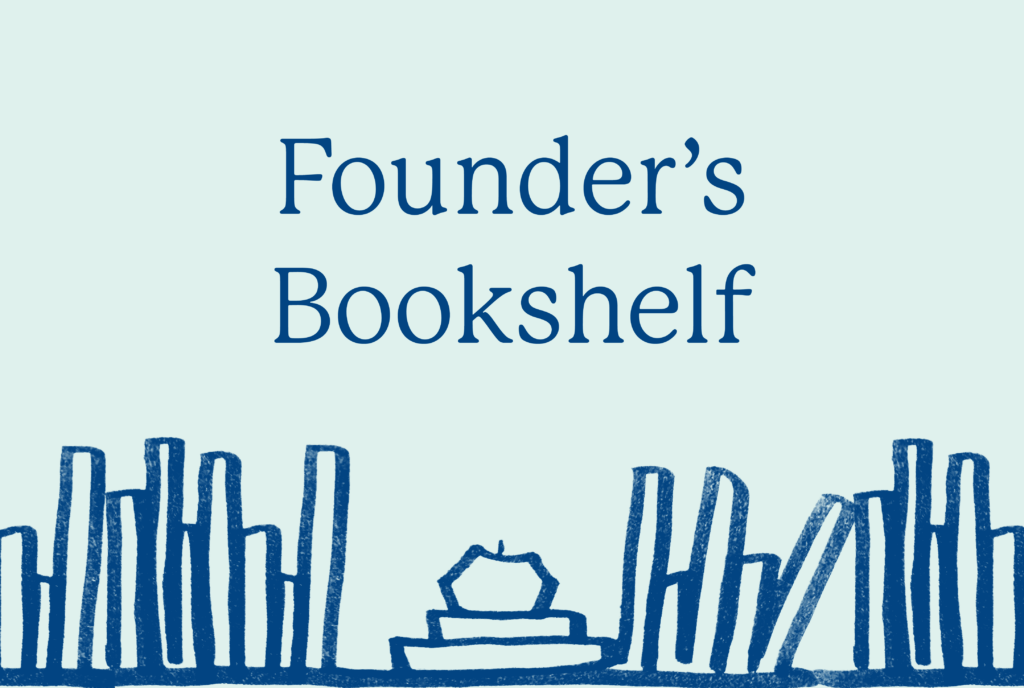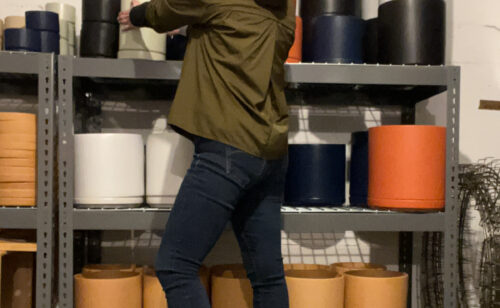
I went into business for myself in 2004. At first, it was just me on my laptop, sideways on the couch, working any and every hour. Then, in 2008, I was pregnant, and figured it would be hard to keep doing the whole business all by myself. I started hiring a team to replace me.
At first, my group was a scrappy team of freelancers. Eventually, I hired enough people that I needed more structure. For some crazy reason, I copied the corporate template. I structured our workweek the way I thought I was supposed to. Apart from some time zone differences, we generally fell into a 40-hour week, 9 to 5, Monday to Friday job.
In 2021, I was ready to rethink all that! I wanted to build a dream job for me, and also for my team. I got super curious about a flurry of news articles on businesses switching to a four day week. I read a couple of books on this topic (find those articles and books linked below this post). I started mentioning it to my team.
They weren’t sure it was realistic, and it took some time to convince them. We decided to give it a try, to make us more productive, and provide a great benefit to the team. In 2022, we joined the 4 Day Week Global pilot program, and streamlined everything we do. I’m happy to say our trial was a success, and Aeolidia now officially works a four day week.
Here are the broad strokes of how we did it and what we learned.
Why the four day week?
“So often people are working hard at the wrong thing. Working on the right thing is probably more important than working hard.”
Caterina Fake
This quote has been my guiding thought about decreasing work hours. I am a firm believer in the Pareto (or 80/20) Principle, that says 80% of consequences come from 20% of causes. That 20% that’s working is what I want to spend my time on.
There are numerous studies which suggest that the longer a person works, the less productive they are. Research shows that people tend to focus in bursts of twenty minutes, up to a total of five hours in a day. Beyond that, cognitive ability, critical thinking, and productivity all show significant declines. Most companies who try a four day week end up seeing the same or better productivity compared to their previous schedule.
For us, the aim of adopting a four day week was not to become a more laid-back place that does less. Our aim was to keep our team’s minds sharp and motivated to strategize on our projects. We always have commitments to our clients, immediate needs, and long-term ambitions. Moving to a four day week was meant to help us achieve our goals more efficiently.
In addition to increasing productivity, the four-day week:
- Helps us with recruitment and retention
- Reduces burnout
- Assists us in being happier and less stressed
- Makes Aeolidia a better, more sustainable place to work
What is the four day week?
The model we’re using is a 100:80:100 model. That means we pay our team 100% salary, complete work in 80% of the time, and maintain 100% productivity. Companies do this successfully when they’re able to cut down on meeting time, use technology to reduce busywork, and improve processes.
We didn’t lower any salaries or start taking longer to complete projects for clients. We also didn’t take on less work than usual. We successfully trimmed our workweek down to the essentials. The logistics will be different for every company. I’d like to share what we did as an example of what you might want to consider if bringing this idea to your company.
How we prepared
We committed to a six-month trial with 4 Day Week Global. They supported us in mindset changes and tactics necessary to increase efficiency. They also partnered with Boston College to provide scientific research surveys. These showed how things changed through the trial for each of Aeolidia’s employees. They didn’t drop in, tell us how to do it, and then leave; we worked together as a team to figure it out for ourselves.
This change could be hard for a team to make if they weren’t already efficient and streamlined. We had some great systems in place which made for a smooth transition. Before knowing that we’d be embarking on the four-day week project, we had recently improved our core processes.
I have a hard time seeing anything as a pure failure in my business. It could have been devastating when all three members of our project management team quit, one at a time, through the pandemic. We took it as an opportunity to fix our processes, and make everything feel totally “Aeolidia” again.
It wasn’t exactly fun spending eight months as a project manager alongside of my Director of Operations. What we built strengthened the business significantly, however. We created a new templated task, tutorial, and scheduling project management system. We completely revamped it in ClickUp with expert help from ZenPilot. It’s now so dependable that we could almost use it to franchise Aeolidia.
For weekly tips like this, subscribe to our newsletter
"*" indicates required fields
We use the Entrepreneurial Operating System (EOS) to run our business. EOS allows us to uncover and fix issues on a weekly basis. When we hit a snag with the four-day week, we take it to our next operations meeting and work it out with the team.
We had worked with Sprout HR to create an employee handbook many years ago. It was easy to adjust the policies in this resource. During the trial, we set temporary policies about time off, and finessed then finalized them during our trial. These included things such as:
- Which day to take off
- How to adjust vacation and PTO policies
- Holidays
- What to do about urgent requests over long weekends
How we strategized
To prepare, we had weekly team discussions (asynchronous, in ClickUp) about:
- Eliminating wasted time
- Setting boundaries and expectations
- The illusion of perfection
- Exercise and rest
- Team building
The 4 Day Week team told us that most organizations divide their time this way, on average:
- 5% of time on value-added activities (doing profitable work for clients)
- 35% of time on unavoidable waste (doing internal work that needs to be done)
- 60% of time on avoidable waste
We asked every person on the team to report back to us with anything that they suspected might be a waste of time. For example, doing more work than was necessary, creating work that no one was using, or causing delays. Then we worked together on ways to optimize or remove those tasks.
As Jon mentioned, reusing code is a big one for us. I also need to get better at this. Spending 20 minutes properly saving and documenting code is much better than hours looking through code or trying to remember what website a specific feature was used on.
Iran Mateu, Aeolidia developer
We talked about “gold plating” projects—doing additional work that was of no practical help in meeting our clients’ goals. We made sure we were still solid about setting expectations for project scope.
While researching, I came across the theory of the aggregation of marginal gains. Dave Brailsford, a cycling coach, explained it with a bicycling metaphor. If you think of everything that goes into riding a bike, and then improve each by 1%, all those tiny changes add up to a big increase.
We worked in groups to tackle inefficiencies in each department of our business. For us, this is design, development, and project management, as well as sales and marketing. From these discussions, we came up with big and small ideas to make everything work better. We scheduled time to put those changes in place, and found ways to track our progress on improvements.
There was also personal development for each of us. We read a book about our chronotypes to find out when we are each most likely to do our best work in a day. We planned practices for our own individual rest and exercise so we could recharge and take care of our bodies and minds. We thought of some ways that we could still stay close as a team, even with less meetings and free time.
How we work now
Some pleasant surprises about the four day week: More focus, less time wasting, more motivation to get tasks done. No more lull days where you feel like the weekend is so far away and you still need to rally (that was usually Thursdays for me). The weeks fly by, the weekend always feels so close. Work doesn’t feel like the biggest thing you do in your life but rather something significant you do along with other things.
Barbara Kowalski, Web Designer at Aeolidia
We work 32 hour weeks now. We kept our web design, development, branding, and email projects to the same number of weeks as usual. We did this by making two big changes, among dozens of smaller ones.
First, we cut down on meetings: less meetings, shorter meetings, less people in each meeting. We also try to not have a meeting whenever we can. “This meeting could have been an email” is a meme for a reason.
Part of the changes to meetings meant revisiting our policies on respecting and preserving other peoples’ time. It’s easy to distract people when your whole team is in Slack chatting. We made sure we had guidelines on what calls for a meeting, an email, a task, or a Slack message.
Second, we discovered and prioritized our truly important work. There are areas where we still want to get an A or A+, but some things we’re now willing to put in a C amount of effort on. Some things we completely quit doing. It’s important to bring our best work to our design and development projects, so most of our cuts were to administrative tasks.
There were wasteful things here and there that had gotten baked into our system over time. For instance, our designers had a task on every project to create multiple graphics for our portfolio. In reality, we only ended up publishing a handful of case studies each year. We now create these as needed, not proactively.
Everyone on the team knows that they have to get the same amount of work as usual done in four days, rather than five. The “fifth day” off is not a right; it’s a privilege earned by keeping tasks on schedule. This is extraordinarily motivating during the first four days of the week. We spend less time getting distracted, and only take purposeful breaks each day. We just don’t have time to waste time!
Communication
I needed to communicate this to our team and to our clients. We let everyone know that we were trialing the practice, and that work policies might change during our first six months. Much was up in the air as we figured out how best to optimize our company.
With the team, I wanted them to feel sure that this didn’t mean a drop in pay. It didn’t mean work was slowing down or we were on our way to a round of layoffs. Our leadership team made sure they knew we weren’t expecting them to work faster or work less. We wanted them to do deep work, minus the things that were wasting our time before.
I knew this could be a surprise for the shop owners we work with. In my message to them, I emphasized that they wouldn’t lose any of our time or see our work drop in quality. Instead, I let them know that we are constantly building the skills needed to complete their work faster than ever.
The shop owners we work with are creatives, too, and they understand that creative work flourishes with rest and balance. In fact, one of our project managers tried to send a few emails on Fridays, when we first started taking the day off. She stopped after getting reminders from our clients that they weren’t expecting to hear from her until Monday!
Results
A lot of the work we do for clients is creative. Obviously our designers need to tap into their creativity all the time. But, also, complex development solutions require a ton of creative thinking. And as a strategist, I need to be seeing connections and finding fresh insights. Having more space in our lives to recharge and fuel our brains – read, visit a museum or gallery, learn a new skill or craft – has enabled us to do even better work during the 4 days when we are at our desks.
Helen Hulskamp
Our finance team verified for us that we achieved 100% of our pre-trial productivity in 2022 and 2023. Our profitability remained strong, and our utilization rates were on target. We were completing the same type of projects on the same schedules as before.
I mentioned that Boston College surveyed our team. They sent out anonymous surveys to our team before, during, and after the trial. Every question had a numerical response, and then they showed us which numbers went up and which went down. Here are the top ten increases and decreases for individuals on our team.
Top ten increases after our trial:
These things went up for our core team of nine as we worked less days, in order of how much they increased for individuals.
- Satisfaction with time
- Exercise frequency
- Work-family balance
- Life satisfaction
- Satisfaction with household finances
- Mental health
- Satisfaction with relationships
- Positive emotions
- Physical health
- Work-life balance
Top ten decreases after our trial
These things went down for our core team of nine as we worked less days, in order of how much they decreased for individuals.
- Work absences due to health
- Family-to-work conflict
- Sleep problems
- Domestic travel
- Anxiety
- Work-to-family conflict
- Fatigue
- Burnout
- Negative emotions
- Turnover intentions
As you can see, all the things you’d want to have more of went up. All the things you’d want less of went down. It was clear that this was a good change for our team.
Juliet Schor from Boston College recently reached out to us to share a paper they’ve written about their research. She says:
In it we show why the four day week leads to well-being improvements for employees—it’s the reduction in worktime, not surprisingly. And bigger reductions yield bigger improvements. There are two pathways. One is from the workplace—the large jump in people’s work ability and productivity which worktime reduction leads to. That’s really important. The second is lifestyle changes in sleep and fatigue. Together, these factors explain most of the well-being improvements!
Juliet Schor
We’ve listed one full-time position since switching to the four day week, and I’ve never received so many job applications in my life! I can’t be sure if it’s the state of the job market right now, or our benefits, but mentioning a four day week certainly doesn’t hurt a job listing.
Perplexingly, we expected Fridays to be for hobbies or fun, but most of us found that they became errand days. Sometimes Fridays ended up being days of recovery after a tough week. That leaves us with the rest of the weekend for those other things, though, which is great.
Planning this project together and seeing success was a wonderful team bonding experience. It’s something we all made happen together. Usually we’re working somewhat more individually or in small groups with a variety of client projects. Having one goal to all pull toward as a team was invigorating.
Keeping on track
Now that we’ve been doing this for some time, the tricky part is to stay on track. There are a few things I’m doing now to support this.
We have documented the process and mindset changes, as well as the conversations we had. Any new employees will be tasked to review this information, and go through their own four day week transformation. We’ll want them to put in the work that the team originally put in to prepare for the pace and processes of a four day week.
As a team, we’ll take time quarterly to remind ourselves what we did to make this work. One thing that the EOS system has taught us is that at the end of every 90 day cycle, we become unfocused. That’s why we review everything and create new goals each quarter.
In the same way that we reset our priorities each quarter, we’ll reset our four day mindset. We’ll have talks about the “waste categories” of work, perfectionism, and team building. We’ll be vigilant about the work that goes into efficiency, so we can continue to meet deadlines without burnout.
Conclusion
Apart from the benefits to my team from a balance and burnout perspective, it has made good business sense to work less. What we produce is better, our time at work is more purposeful, and our profitability is strong. We have been working 80% as many hours as we used to for well over a year, and it’s been such a positive change.
My goal is for Aeolidia to be a dream job for our employees, and a “dream hire” for our clients. This new schedule aligns well with our values. It’s been exciting to see what we can do for our favorite shop owners when we’re all at our best!
Resources
Need an efficient, engaged, enthusiastic team to help you or a colleague with an online shop? Please get in touch! We would be glad to help.
Here are some things that were useful to me and my team.
Organizations
- 4 Day Week Global organization – for help and resources
- Diary Detox system
Books
- The 4 Day Week, by Andrew Barnes
- Shorter, Work Better, Smarter, and Less—Here’s How by Alex Soojung-Kim Pang
- Burnout, The Secret to Unlocking the Stress Cycle by Amelia & Emily Nagoski
- Deep Work and Slow Productivity, by Cal Newport
- It Doesn’t Have to Be Crazy at Work, by the Basecamp dudes
- The Power of When, by Michael Breus
Grab a list of all the books that helped build Aeolidia here.
News articles
- NPR: The 40-hour workweek isn’t working. Reducing it could help with productivity
- BBC: The case for a shorter workweek
- NYT: The future of work should mean working less
- Washington Post: A history of the made up five-day workweek
- Fast Company: Why remote work may render the 5-day workweek obsolete
Tactical articles
- Asana: Understanding the Pareto Principle (80/20 rule)
- HBR: Burning out? Give yourself permission to dial it back.
- New Yorker: It’s time to embrace slow productivity
- Harvest: Timeless tips for developing good time management skills
- HBR: How to create the perfect meeting agenda
- Productive Flourishing: How to be a productive powerhouse using time blocking
- Gitlab: How to embrace asynchronous communication for remote work
- RescueTime: How to design the most restful possible day off
- RescueTime: How to use Slack effectively
- Quartz: If you want fewer meetings, measure them in cash
The Founder’s Bookshelf

These are all books which have significantly influenced Aeolidia for the better, and which I recommend to any business owner.
Related Posts
Let's take your online shop to the next level
The Shopify websites we design have a reputation for substantial improvements to ecommerce conversion rates and online sales. Let's talk!
















1 thought on “How Switching to a Four Day Week Improves Productivity”